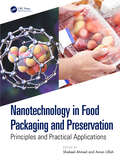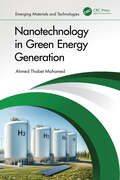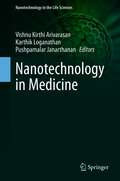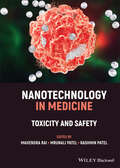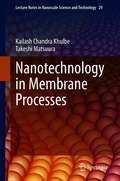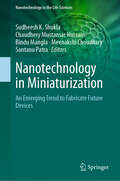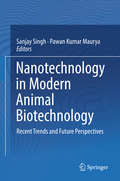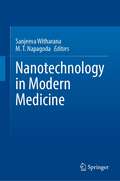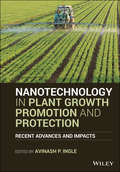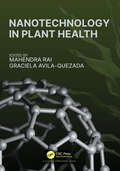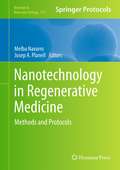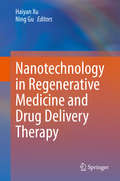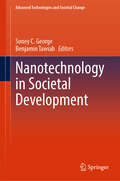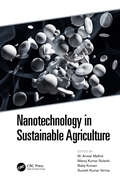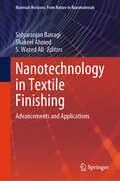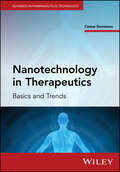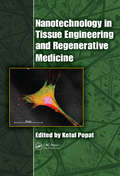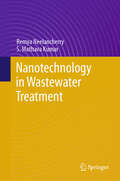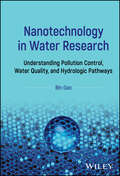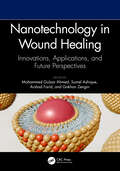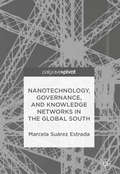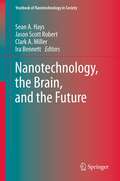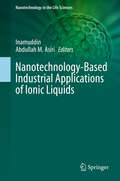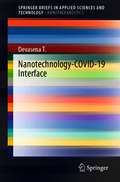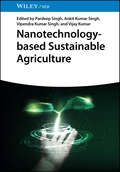- Table View
- List View
Nanotechnology in Food Packaging and Preservation: Principles and Practical Applications
by Shakeel Ahmed Aman UllahThis book provides a comprehensive overview of the use of nanotechnology in food preservation, food packaging, and the development of novel preservation methods. The chapters focus on applications of nanotechnology in active food packaging, modified atmosphere packaging, and the development of nanocomposite films and coatings for food packaging. Additionally, the book further explores the potential of nanosensors and biosensors for real-time monitoring of food quality and safety and provides insightful case studies showcasing successful nanotechnology applications in the food industry. It also discusses the potential challenges and limitations of using nanotechnology in food preservation, as well as the regulatory and safety concerns that need to be addressed. Furthermore, the book examines consumer perceptions and acceptance of nanotechnology in food preservation and concludes by comparing nanotechnology-based methods with traditional approaches, paving the way for future directions and advancements in this field. This book is a valuable resource for researchers, practitioners, and policymakers in the food industry.Key Features: Provides an overview of application of nanotechnology in food packaging and preservation Discusses the potential of nanotechnology in active food packaging, modified atmosphere packaging, and nanocomposite films for packaging Reviews the potential of nanosensors and biosensors for real-time monitoring of food quality and safety Explores potential challenges and limitations related to nanotechnology in food preservationExamines consumer perceptions and acceptance of nanotechnology in food preservation Presents real-world case studies on the use of successful nanotechnology implementations in the food industry
Nanotechnology in Green Energy Generation (Emerging Materials and Technologies)
by Ahmed Thabet MohamedNanotechnology in Green Energy Generation provides a comprehensive review of modelling, processing, and applications of all major categories of green energy generation materials. It explores different areas of green energy generation including hydrogen, solar, and wind energies, covering aspects such as synthesis, morphology, materials, and characterization.Presenting the fundamental principles in the design and utilization of green energy generation materials, the book discusses the construction and equivalent circuits of traditional and new green energy cells. In addition, it provides thermal analysis and comparative studies with traditional power generation, including operation and cost-efficiency of new generation cells and modules. The book also includes many case studies, laboratory experiments, and research results throughout the chapters.The book will be a valuable reference for applied researchers, academic researchers and graduate students studying advances in energy engineering, nanotechnology, and materials and composites.
Nanotechnology in Medicine (Nanotechnology in the Life Sciences)
by Vishnu Kirthi Arivarasan Karthik Loganathan Pushpamalar JanarthananNanomedicine is the field of science that deals with organic applications of medicine at the nano-scale level. It primarily addresses finding, anticipating, and treating sickness, as well as using nanotechnology to assist in controlling human frameworks at the cellular level. The nature of nanotechnology allows it to address numerous medical issues in humans. This book offers comprehensive information to better comprehend and apply multifunctional nanoparticles in nanomedicine, and thus open avenues in the field.Medicating at the nanolevel is an exceptional therapeutic avenue, as it avoids symptoms associated with conventional medicines. This book investigates recent insights into structuring novel drug delivery frameworks. It concentrates on the physical characteristics of drug delivery transporters, and the preliminary procedures involved in their use. The book offers in-depth detail that benefits academics and researchers alike, containing broad research from experts in the field, and serves as a guide for students and researchers in the field of nanomedicine, drug delivery, and nanotechnology.
Nanotechnology in Medicine: Toxicity and Safety
by Mahendra Rai Mrunali Patel Rashmin PatelNANOTECHNOLOGY IN MEDICINE Discover thorough insights into the toxicology of nanomaterials used in medicine In Nanotechnology in Medicine: Toxicity and Safety, an expert team of nanotechnologists delivers a robust and up-to-date review of current and future applications of nanotechnology in medicine with a special focus on neurodegenerative diseases, cancer, diagnostics, nano-nutraceuticals, dermatology, and gene therapy. The editors offer resources that address nanomaterial safety, which tends to be the greatest hurdle to obtaining the benefits of nanomedicine in healthcare. The book is a one-stop resource for recent and comprehensive information on the toxico logical and safety aspects of nanotechnology used in human health and medicine. It provides readers with cutting-edge techniques for delivering therapeutic agents into targeted cellular compartments, cells, tissues, and organs by using nanoparticulate carriers. The book also offers methodological considerations for toxicity, safety, and risk assessment. Nanotechnology in Medicine: Toxicity and Safety also provides readers with: A thorough introduction to the nanotoxicological aspects of nanomedicine, including translational nanomedicine and nanomedicine personalization Comprehensive introductions to nanoparticle toxicity and safety, including selenium nanoparticles and metallic nanoparticles Practical discussions of nanotoxicology and drug delivery, including gene delivery using nanocarriers and the use of nanomaterials for ocular delivery applications In-depth examinations of nanotechnology ethics and the regulatory framework of nanotechnology and medicine Perfect for researchers, post-doctoral candidates, and specialists in the fields of nanotechnology, nanomaterials, and nanocarriers, Nanotechnology in Medicine: Toxicity and Safety will also prove to be an indispensable part of the libraries of nanoengineering, nanomedicine, and biopharmaceutical professionals and nanobiotechnologists.
Nanotechnology in Membrane Processes (Lecture Notes in Nanoscale Science and Technology #29)
by Takeshi Matsuura Kailash Chandra KhulbeNanotechnology has been established in membrane technology for decades. In this book, comprehensive coverage is given to nanotechnology applications in synthetic membrane processes, which are used in different fields such as water treatment, separation of gases, the food industry, military use, drug delivery, air filtration, and green chemistry. Nanomaterials such as carbon nanotubes, nanoparticles, and dendrimers are contributing to the development of more efficient and cost-effective water filtration processes. Gas separation and carbon capture can be significantly improved in flue gas applications. Nanoporous membrane systems engineered to mimic natural filtration systems are being actively developed for use in smart implantable drug delivery systems, bio artificial organs, and other novel nano-enabled medical devices. The microscopic structure of nanoporous ceramic membranes, mainly focusing on zeolite materials, as well as the energy-saving effect of membrane separation, contribute to various chemical synthesis processes. In the food industry, nanotechnology has the potential to create new tools for pathogen detection and packaging. For each application, nanotechnology is mostly used to make composite membranes, and the book provides a detailed look at the mechanisms by which the composite membrane works in each application area.
Nanotechnology in Miniaturization: An Emerging Trend to Fabricate Future Devices (Nanotechnology in the Life Sciences)
by Chaudhery Mustansar Hussain Sudheesh K. Shukla Bindu Mangla Santanu Patra Meenakshi ChoudharyNanotechnology is rapidly growing as a new technology alternative to create advance materials with unique characteristics and performance for vast applications in a range of industrial sectors. In recent years, a number of nanotechnology-based products have appeared in our day-to-today lives. On the other hand, industries have also considered nano-concepts to produce high-added value products with superior capacity, reliability, and efficiency. The field of nanotechnology is one of the most popular areas for current research and development in almost all technical disciplines. This includes miniaturization of microelectronics, nanomedicine, nano-emulsion particles, fuel cell catalysts, self-assembled polymer films, nanofabrication, imprint lithography, and more. This book summarizes recent advances in miniaturization using nanotechnological approaches. The ability to interact with matter at nanoscale has led to the development of nanoarchitecture and nanomaterials which have the capability of exceeding the limits of conventional modalities. This book provides insight into the development and trends which are progressing quickly in the field of nano-miniaturized-based devices and tools. This book offers an overview of the evolution of miniaturization of engineering systems and devices, which was initiated over one-half century ago. The trend of further miniaturization of devices to the ultimate atomic scale will not only continue, it will become a dominant technological development in the first half of the new century, if not for longer. Such development will require significant changes in every aspect of design and manufacturing, as well as production management over traditional engineering practices. Production of miniaturized device components and engineering systems of micro- and nanoscale is clearly beyond the capability of current machine tools. Manufacturing of nano-scaled devices and components involves isolation, transportation, and re-assembly of atoms and molecules. This nanomachining technology involves not only physical-chemical processes as in the case of microfabrication, but it also involves application and integration of the principles of molecular biology.
Nanotechnology in Modern Animal Biotechnology: Recent Trends and Future Perspectives
by Pawan Kumar Maurya Sanjay SinghThe book introduces the basic concepts of nanotechnology and the various technologies to characterize nanomaterials. It also covers the nanostructural features of mammalian cells/tissues and related nanomechanical properties. In addition, the book comprehensively describes the current state-of-the-art and future perspectives of nanotechnology in biosensors. It also discusses the potential of nanotechnology for delivering the diverse cancer therapeutics and illustrates its limitation due to the potential toxicity associated with oxidative stress. It also highlights the ethical issues and translational aspects related to nanotechnology. Finally, it summarizes the applications of nanotechnology in animal biotechnology, the recent perspectives and future challenges of nanomedicines. The content of the book are beneficial for the undergraduate, postgraduate and doctoral students as well the professionals working in the area of nanotechnology and nanomedicines.
Nanotechnology in Modern Medicine
by Sanjeeva Witharana M. T. NapagodaThis book highlights the applications of nanotechnology in modern medicine. Today we are living in a world of fast-changing behavior and lifestyles. Despite health and wellbeing are often pronounced and enforced, the diseases and illnesses are emerging in different forms, at an alarming rate. Protecting the mankind is becoming ever more challenging. In this backdrop, medicine needs new approaches and technologies to build the defenses. Nanotechnology is successfully confronting the situation. It does so in two avenues, namely, nanomaterials, and, nanodevices. Nanomaterials possess extraordinary properties that are utilized to confront bacteria and viruses, and for targeted drug delivery. Nanodevices can be maneuvered inside the human body to reach extreme locations. This book presents the latest developments in these areas.
Nanotechnology in Plant Growth Promotion and Protection: Recent Advances and Impacts
by Avinash P. IngleDiscover the role of nanotechnology in promoting plant growth and protection through the management of microbial pathogens In Nanotechnology in Plant Growth Promotion and Protection, distinguished researcher and author Dr. Avinash P. Ingle delivers a rigorous and insightful collection of some of the latest developments in nanotechnology particularly related to plant growth promotion and protection. The book focuses broadly on the role played by nanotechnology in growth promotion of plants and their protection through the management of different microbial pathogens. You’ll learn about a wide variety of topics, including the role of nanomaterials in sustainable agriculture, how nano-fertilizers behave as soil feed, and the dual role of nanoparticles in plant growth promotion and phytopathogen management. You’ll also discover why nanotechnology has the potential to revolutionize the current agricultural landscape through the development of nano-based products, like plant growth promoters, nano-fertilizers, nano-pesticides, and nano-insecticides. Find out why nano-based products promise to be a cost-effective, economically viable, and eco-friendly approach to tackling some of the most intractable problems in agriculture today. You’ll also benefit from the inclusion of: A thorough introduction to the prospects and impacts of using nanotechnology to promote the growth of plants and control plant diseases An exploration of the effects of titanium dioxide nanomaterials on plant growth and the emerging applications of zinc-based nanoparticles in plant growth promotion Practical discussions of nano-fertilizer in enhancing the production potentials of crops and the potential applications of nanotechnology in plant nutrition and protection for sustainable agriculture A concise treatment of nanotechnology in seed science and soil feed Toxicological concerns of nanomaterials used in agriculture Perfect for undergraduate, graduate, and research students of nanotechnology, agriculture, plant science, plant physiology, and crops, Nanotechnology in Plant Growth Promotion and Protection will also earn a place in the libraries of professors and researchers in these areas, as well as regulators and policymakers.
Nanotechnology in Plant Health
by Mahendra Rai Graciela Avila-QuezadaNanotechnology is an emerging, pivotal platform for enhancing plant health. On one hand, nanomaterials serve as crucial nutrients and nanofertilizers, while on the other, they have demonstrated their potential for diagnosing plant diseases, delivering fungicides and pesticides, and providing therapeutic solutions against diseases caused by pathogens and parasites.The book Nanotechnology in Plant Health explores the significance of nanomaterials in plant nutrition, nanofertilizers, and their role in managing plant pathogens, including the most formidable ones like quarantined strains. This unique publication represents a global team of contributors and stands out for its comprehensive coverage of plant nanonutrients, nanofertilizers, and nano-plant protectors.
Nanotechnology in Regenerative Medicine
by Josep A. Planell Melba NavarroNanotechnology plays a key leading role in developing tools able to identify, measure, and study cellular events at the nanometric level as well as in contributing to the disclosure of unknown biological interactions and mechanisms, which opens the door for advances including nanodevices for diagnostic and therapy, drug delivery systems, and regenerative medicine. In Nanotechnology in Regenerative Medicine: Methods and Protocols, expert researchers in the field provide an overview of a very wide range of currently used technologies and methods that involve nanotechnology principles applicable to tissue regeneration. Being that the application of nanotechnology to regenerative medicine is a very broad field, this book focuses its interests on particular areas such as its use as a means to produce efficient platforms and structures for tissue engineering, delivery systems and biosensors, as well as the use of some techniques to study materials surfaces and the interactions between cells, biomolecules, and surfaces at the nanoscale. Written in the highly successful Methods in Molecular BiologyTM series format, chapters include introductions to their related topics, lists of the necessary materials and reagents, step-by-step, readily reproducible laboratory protocols, and tips on troubleshooting and avoiding known pitfalls. Authoritative and accessible, Nanotechnology in Regenerative Medicine: Methods and Protocols provides established scientists, junior researchers, and students involved in the bioengineering, biotechnology, and biomedical fields with a sound foundation in a variety of vital nanotechnology approaches in regenerative medicine.
Nanotechnology in Regenerative Medicine and Drug Delivery Therapy
by Haiyan Xu Ning GuThe book focuses on the application of nanotechnologies in scaffold-guided tissue regeneration and in drug delivery systems for use in immunotherapy and overcoming drug resistance in cancer treatment. It covers a variety of topics, including nanomaterials for immunomodulation and immnunotherapy; molecular studies on self-assembly for peptides and DNA and related applications in tumor diagnosis and therapeutics and against human pathogenic bacteria; magnetic and conductive scaffolds for guiding tissue regeneration; multiple functions of magnetic nanoparticles in drug delivery and regenerative medicine; and re-purposing of traditional medicine in nano-formulations. In addition, it discusses common effects of nanomaterials, including reactive oxygen species and protein corona. Providing valuable insights and the presenting the latest research advances, the book allows readers to gain a systematic understanding of the topic.
Nanotechnology in Societal Development (Advanced Technologies and Societal Change)
by Soney C. George Benjamin TawiahThis book investigates the complex effects of nanotechnology across numerous fields such as nanomedicine, tailored therapy in medicine and health care, transformational treatment choices for various illnesses, electronics, and computing via miniaturization. In addition, the contributions of nanotechnology to quantum computing, and flexible electronics has been examined. More so, the book discusses the advantages of nanotechnology in the energy and environmental sectors, such as solar cells, energy storage systems, and water purification technologies, in order to solve major global concerns. The impact of nanotechnology on materials and production processes, with applications in construction, aerospace, and other fields, is highlighted. The book further discusses the ethical and societal issues such as safety, privacy, equal access, and thoroughly examined how to strike a balance between innovation and responsible development of nanotechnology in the context of stringent rules and proactive risk assessment. Furthermore, the ability of nanotechnology to bridge the technological divide in underdeveloped nations while minimizing environmental implications is also highlighted.
Nanotechnology in Sustainable Agriculture
by M. Anwar Mallick, Manoj Kumar Solanki, Baby Kumari, and Suresh Kumar VermaNanotechnology in Sustainable Agriculture presents applications of nanobiotechnology for eco-friendly agriculture practices. Implementing sustainable agriculture techniques is a crucial component in meeting projected global food demands while minimising toxic waste in the environment. Nano-technological tools – including nanoparticles, nanocapsules, nanotubes and nanomolecules – offer sustainable options to modernise agriculture systems. Written by nanotechnology experts, this book outlines how nano-formulations can improve yield without reliance on chemecial pesticides and reduce nutrient losses in fertilization. It reveals how nanotools are used for rapid disease diagnostics, in treating plant diseases and enhancing the capacity for plants to absorb nutrients. Features: Combines nanotechnology and agronomy presenting applications for improving plant performance and yields. Reveals nanotechnology-based products used for the soil and plant health management which mitigate climate change. Discusses roles of microbial endophytes, heavy metal nanoparticles and environment health, nano-nutrients, phytochemicals, green bioengineering and plant health. This book appeals to professionals working in the agriculture and food industry, as well as agricultural scientists and researchers in nanotechnology and agronomy.
Nanotechnology in Textile Finishing: Advancements and Applications (Materials Horizons: From Nature to Nanomaterials)
by Shakeel Ahmed S. Wazed Ali Satyaranjan BairagiThis book is focused on the latest developments and practical applications of nanotechnology in textile finishing. It covers the fundamentals of nanotechnology, including the properties and behavior of nanoparticles, and how they can be used to enhance the performance of textiles. The book also explores the various types of nanomaterials that are used in textile finishing, such as nanoparticles, nanocomposites, and nano-coatings, and their properties, advantages, and limitations. The book covers the different types of textile finishing techniques, including dyeing, printing, and coating, and how nanotechnology is used to improve their performance. It also covers the environmental, health, and safety aspects of using nanotechnology in textile finishing, and the challenges and opportunities that lie ahead. The book is targeted at textile scientists, engineers, and researchers working in the textile industry, as well as students and academics in textile science and engineering. It is also useful for those in related fields, such as materials science, chemistry, and chemical engineering.
Nanotechnology in Therapeutics: Basics and Trends (Advances in Pharmaceutical Technology)
by Costas DemetzosNanotechnology in Therapeutics Comprehensive reference delivering a framework to develop and assess nanosystems that provide unique advantages in biomedical applications Nanotechnology in Therapeutics explores the idea that by studying in depth the behavior of living organisms, especially the functionality of their cell membranes, we can develop and evaluate innovative bio-inspired nanosystems that are able to deliver small molecules, biomolecules like proteins, peptides, and other genetic material in terms of the production of new therapies and vaccines. The main concept promoted in this book is an integrated approach for producing new medicines following the nanotoxicity, biotoxicity, regulatory, and ethical guidelines, which are also covered in the book. The book is divided into three parts. Part A provides an introduction and a historical overview of nanotechnology. Part B delves deeper into issues relating to lipid and polymeric nanostructures in medicine. Part C presents the regulatory landscape around nanotechnology and nanomedicine, while highlighting the need to keep an eye on emerging technologies such as artificial intelligence and machine learning. Overall, this book opens up biomedical applications for previously challenging drugs and drug targets. Written by a highly qualified professor with significant pertinent research experience, Nanotechnology in Therapeutics includes discussion on: Eukaryotic cell membranes, their structural properties, and the thermodynamic payload of their lipid bilayersThe DLVO (Derjaguin, Landau, Verwey and Overbeek) theory as a scientific tool for studying the stability and the behavior of nanoparticlesLiposomes, lipid nanoparticles, and solid lipid nanoparticles, as well as polymeric nanoparticles, like micelles, polymersomes, and dendrimersIssues in the approval process of nanomedicines by the regulatory agencies, such as complexity, chaos, and nonlinear dynamics With comprehensive coverage of novel concepts that have the potential to transform how new medicines are designed and developed, Nanotechnology in Therapeutics is an essential resource on the subject for chemists in industry, as well as biomedical and pharmaceutical engineers.
Nanotechnology in Tissue Engineering and Regenerative Medicine
by Ketul PopatAlthough nanotechnology applied to medicine has a potentially huge impact on drug delivery and tissue engineering, significant challenges need to be resolved before clinically viable nanomedicine or nanobiomedicine therapies will be available. Skillfully edited, with contributions from an expert panel of researchers, Referred to as "nanomedicine" or "nanobiomedicine," the application of nanotechnology to medicine can impact diagnosis, monitoring, and treatment of diseases, as well as the control and understanding of biological systems. Bringing together an unparalleled field of experts, this volume explores various aspects of nanotechnology and its applications in biomedical fields. The book uses an application-oriented approach to relate laboratory-based research to the development of technologies that are easily adaptable to an industry environment, focusing chiefly on drug delivery, tissue engineering, and regenerative medicine.
Nanotechnology in Wastewater Treatment
by Remya Neelancherry Mathava Kumar SThis book aims at providing comprehensive insights focusing on the ongoing research in application of nanotechnology in environmental systems with focus on wastewater treatment. It deals with the synthesis, characterization and employment of nanomaterials for ecological remediation. This book is of primary interest to academicians, researchers, scientists and engineers working in the field of application of nanomaterial in environmental management. This book aims to provide knowledge about recently developed applications of nanotechnology in wastewater treatment in a comprehensive and structured manner. Nanotechnology, being a research area of increasing significance, is still being explored to further depths. This book also focuses on collectively discussing the technologies developed so far and attempts to pave the way for possible future developments. This book addresses the challenges of pollutant removal during wastewater treatment and constructively discusses the innovative and effective solutions that nanotechnology has to offer for the same. It also elaborately discusses the nanotechnology-based treatment methods for emerging contaminants and other refractory pollutants removal from water/wastewater.
Nanotechnology in Water Research: Understanding Pollution Control, Water Quality, and Hydrologic Pathways
by Bin GaoHolistic perspective on environmental nanotechnology and its impact on water quality, focusing pollution control, water quality, and hydrologic pathways Nanotechnology in Water Research delves into the intersection of nanotechnology and environmental science, exploring the transformative potential of nanotechnology in addressing environmental challenges. The book discusses the characterization, stability, transport, and fate of nanomaterials in water systems, particularly in hydrologic pathways, the applications of nanotechnology in water pollution control, and significant scientific problems and advancements in nanotechnology’s role in water research. This title includes information on: Nanotechnology and nanoparticle concepts, with many examples related to water quality technologies Improving water treatment methods while ensuring environmental sustainability Sensor, remediation, adsorption, and membrane processes that detect, monitor, remove, reduce, or neutralize water contaminants Analytical technologies, stability theory, filtration theory, and fate and transport of nanoparticles in water to help reduce risks to humans and aquatic systems Equally valuable as a reference, handbook, textbook, and general learning resource, this essential guide is an excellent read on the subject for students, educators, researchers, professionals, and stakeholders in environmental engineering, nanotechnology, and environmental science.
Nanotechnology in Wound Healing: Innovations, Applications, and Future Perspectives
by Sumel Ashique Arshad Farid Mohammed Gulzar Ahmed Gokhan ZenginThis book comprehensively reviews the role of engineered nanomaterials in wound healing. It presents green synthesized nanomaterials for wound healing and cell growth stimulation and explores the advanced application of nanocellulose. The book highlights innovative approaches like smart 3D printed hydrogels and drug-loaded nanomaterials, as well as natural bioactive compounds encapsulated within nanomaterials. It also covers advancements in nanomaterial-based drug delivery systems and the integration of artificial intelligence in wound healing. Further chapters discuss the role of the immune system and the extracellular matrix in wound healing, strategies to modulate immune responses, and recent advancements in tissue engineering. The book addresses the mechanisms, limitations, and future perspectives of nanomaterials in wound healing, and emphasizes the importance of toxicity studies.
Nanotechnology, Governance, and Knowledge Networks in the Global South
by Marcela Suárez EstradaThe seemingly unlimited technological potential of nanotechnology brings with it new practices of governance, networking, and exercising power and agency. Focusing on scholars in the Global South, this text covers nanotechnology discourses, imaginaries, and materialities as they circulate and interact within governance knowledge networks. Rather than adapt their actions to existing governance mechanisms and science, technology, and innovation policy, scientists use the imaginary of nanotechnology to create new symbolic and material incentives, thus shaping its governance. By tracing the constantly shifting asymmetries of knowledge and power, the book offers fresh insights into the dynamics of knowledge networks.
Nanotechnology, the Brain, and the Future
by Jason Scott Robert Sean A. Hays Clark A. Miller Ira BennettOur brain is the source of everything that makes us human: language, creativity, rationality, emotion, communication, culture, politics. The neurosciences have given us, in recent decades, fundamental new insights into how the brain works and what that means for how we see ourselves as individuals and as communities. Now - with the help of new advances in nanotechnology - brain science proposes to go further: to study its molecular foundations, to repair brain functions, to create mind-machine interfaces, and to enhance human mental capacities in radical ways. This book explores the convergence of these two revolutionary scientific fields and the implications of this convergence for the future of human societies. In the process, the book offers a significant new approach to technology assessment, one which operates in real-time, alongside the innovation process, to inform the ways in which new fields of science and technology emerge in, get shaped by, and help shape human societies.
Nanotechnology-Based Industrial Applications of Ionic Liquids (Nanotechnology in the Life Sciences)
by Inamuddin Abdullah M. AsiriNumerous solvents used in chemical processes have poisonous and unsafe properties that pose significant ecological concerns ranging from atmospheric emissions to the contamination of water effluents. To combat these ecological threats, over the course of the past two decades, the field of green chemistry has grown to develop more natural reaction processes and techniques involving the use of nonconventional solvents to diminish waste solvent production and thus decrease negative impact on the environment. Ionic liquids in particular are more environmentally friendly substitutes to conventional solvents, and as such, have seen more widespread use in the past decade. They have been used in such processes as extraction, separation, purification of organic, inorganic, and bioinorganic compounds, reaction media in biochemical and chemical catalysis, green organic and drug synthesis, among other industrial applications. Thus, in proving themselves a suitable greener media for economic viability in chemical processes, ionic liquids are leading to more sustainable development. This edition explores the application of ionic liquids as a green solvent. It contains a state-of-the-art overview on ionic liquids as green solvents for chemical processes and techniques, as well as some of their useful industrial applications.
Nanotechnology-COVID-19 Interface (SpringerBriefs in Applied Sciences and Technology)
by Devasena T.This book highlights the role of nanotechnology concepts in the management of COVID-19 pandemic. The book covers different aspects of the causative agent SARS CoV2 (Severe Acute Respiratory Syndrome Coronavirus-2) and the COVID-19 pandemic with a special emphasis on nanotechnology. It discusses the origin and history of SARS CoV2 and the outbreak of COVID-19 and highlights the geographical mutations in the SARS CoV2 virus genome, providing information about the structural features, antigenicity and the life cycle of SARS CoV2. The book provides an insight into nanotechnology–virology interface and explains how nanomaterials link the gap between the vital phases of SARS CoV2 life cycle and the four modalities of COVID-19 management viz sensing/diagnosis, therapy, prevention and self-protection. Further, the existing and promising diagnostic tools for detection of COVID-19 are discussed with an emphasis on nano PCR, nanoimmunosensors, biobarcode assay and point of care approach and also describe the nanoparticles involved in the CT imaging of lungs and SFHI (Spatial Frequency Hetrodyne Imaging) for diagnosis of SARS COV2 infection. The book concludes with details about translational medicine and explains the types of SARS CoV2 vaccines, stages of COVID-19 vaccine development and possible nanovaccines for COVID-19, followed by the description on biopharmaceutical companies involved in the production of SARS CoV2 vaccines.
Nanotechnology-based Sustainable Agriculture
by Vijay Kumar Pardeep Singh Ankit Kumar Singh Vipendra Kumar SinghProvides detailed guidance on harnessing nanotechnology for sustainable agriculture, combines theoretical frameworks with actionable strategies Nanotechnology-based Sustainable Agriculture offers an in-depth exploration of how nanotechnology is revolutionizing agricultural practices to enhance crop productivity and environmental sustainability. Addressing key challenges in conventional agriculture, this volume presents the cutting-edge roles of various nanomaterials, such as carbon nanotubes and quantum dots, in boosting efficiency and reducing environmental impact. Emphasizing practical solutions, ranging from nano biofertilizers and nanobioremediation to innovative pest control strategies, an expert panel of authors provides a roadmap for integrating nanotechnology into sustainable agricultural systems. In-depth chapters describe both the fabrication of nanomaterials and their application in soil quality assessment, pollutant remediation, and crop disease management. Throughout the text, the authors highlight opportunities and address challenges to ensure the safe and effective adoption of these technologies. Enhancing crop productivity and environmental health through innovative solutions, Nanotechnology-based Sustainable Agriculture: Explores a wide range of nanotechnologies for use in agriculture, including plant-based nanomaterials, chitosan nanoparticles, and silver nanoparticlesPresents strategies for minimizing environmental and health impacts while maximizing crop productivityIncorporates the latest developments in nanobiotechnology, phytonanotechnology, and nano-bioremediationDiscusses the challenges and potential risks of nanomaterial-based chemicals in agricultural systemsExamines diverse case studies and strategies to achieve food security and sustainable agriculture on a global scale Nanotechnology-based Sustainable Agriculture is essential reading for advanced students, researchers, and professionals in environmental science, material science, and agriculture. It is well-suited as a textbook for graduate and postgraduate courses in sustainable agriculture or nanotechnology, as well as a reference for professionals in research and development, policymaking, and industry.
